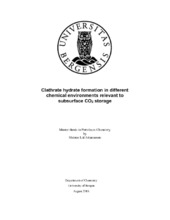Clathrate hydrate formation in different chemical environments relevant to subsurface CO2 storage
Master thesis
Permanent lenke
https://hdl.handle.net/1956/18514Utgivelsesdato
2018-09-12Metadata
Vis full innførselSamlinger
- Department of Chemistry [433]
Sammendrag
Storing of carbon dioxide (CO2) as hydrates in the formation of the subsurface permafrost and oceanic areas around the world is a new method of carbon capture and storage (CCS). Clathrate hydrates are solids consisting of water molecules bonded together in a crystalline structure encapsulating a guest gas molecule (e.g. CO2). Storage of CO2 as hydrate in the subsurface could contribute to limiting the current release of greenhouse gases released into the atmosphere. Furthermore, conventional CCS methods with deposition of CO2 in depleted hydrocarbon reserves and water reservoirs have proposed to use CO2 hydrate as a sealing barrier to limit the migration of liquid CO2 upwards into the formation. This thesis presents a study of the various parameters affecting CO2 hydrate formation in a Bentheimer sandstone core, under realistic in-depth conditions. A range of experiments performed in different chemical environments with THF as an analogue to CO2 was set up to design the parameters for the CO2 hydrate formation experiments in the sandstone cores. Furthermore, the use of Magnetic Resonance Imaging (MRI) have been used for analysis of the macroscopic crystal structure and morphology of THF hydrates with particles of various wetting properties. The formation of CO2 hydrates in Bentheimer sandstone cores was seen to form a solid barrier that prevented further injection when the system was inside the Hydrate Stability Zone (HSZ). These results display the possibility of using CO2 hydrate as a sealing barrier for further migration of liquid stored in conventional water reservoirs. Furthermore, increase in temperature, pressure (only for CO2) and electrolyte concentration was seen to prolong or even prevent the formation of CO2- and THF hydrates. Natural occurring substances, such as Utsira formation water, and particles from Bentheimer sandstone were seen to promote hydrate growth. Use of MRI to study the macroscopic crystal structure and morphology of THF hydrate displayed liquid phase inside what appeared to the visible eye as solid hydrate. The morphology of ice versus THF hydrate in bulk displayed a significantly different structure formed. The natural substances Illite and Bentheimer solid particles were seen to promote formation of liquid channels inside the formed hydrate structure that upon melting obtained more liquid.
